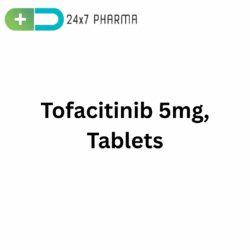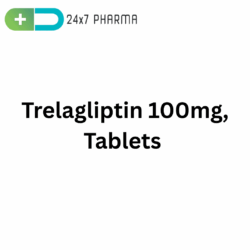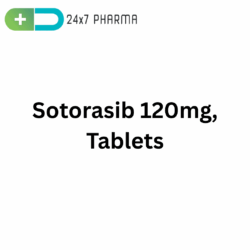LuciTram 2mg, Trametinib Tablets
Trametinib, a powerful oral anticancer drug, is available under the brand name LuciTram 2mg. It is categorized as a MEK inhibitor and is primarily used in the treatment of certain types of melanoma and non-small cell lung cancer (NSCLC). Developed as part of targeted cancer therapy, LuciTram works by interfering with specific cellular pathways that drive cancer progression. It is typically used in combination with dabrafenib, another targeted therapy drug, for enhanced clinical efficacy.
What is LuciTram 2mg (Trametinib)?
Trametinib dimethyl sulfoxide, a reversible inhibitor of the MAPK/ERK signaling pathway’s MEK1 and MEK2 enzymes, is an ingredient in LuciTram. This pathway is often overactive in cancers due to mutations in upstream components like BRAF V600E or V600K. By inhibiting MEK, LuciTram effectively slows or stops the growth of tumor cells with these mutations.
How It Works / Mechanism of Action
Trametinib targets and inhibits the MEK1 and MEK2 kinases, which are downstream of BRAF in the MAPK pathway. The regulation of cell growth, division, and survival depends on this route. In cancers with BRAF mutations, the pathway becomes abnormally active, leading to uncontrolled proliferation.
By selectively inhibiting MEK, Trametinib:
- Reduces tumor cell proliferation.
- Induces apoptosis (programmed cell death).
- Slows tumor progression.
- Enhances the effect of other targeted therapies, such as dabrafenib.
- It is particularly effective in cancers harboring BRAF V600 mutations, making it a personalized treatment option in precision oncology.
How to Use / Indications
LuciTram 2mg is indicated for use in:
- Unresectable or Metastatic Melanoma with BRAF V600E/K mutations (often in combination with dabrafenib).
- Metastatic Non-Small Cell Lung Cancer (NSCLC) with BRAF V600E mutation.
- Anaplastic Thyroid Cancer (ATC) with BRAF V600E mutation (off-label in some cases).
- Adjuvant treatment of BRAF-mutant melanoma following surgical resection.
- Molecular diagnostic testing to verify the existence of the BRAF mutation informs the prescription of the drug.
How to Take / Dosage
Usual Adult Dose:
- Trametinib 2 mg orally once daily, taken on an empty stomach, either 1 hour before or 2 hours after a meal.
- Must be taken at the same time each day for consistent plasma levels.
- When used in combination with dabrafenib, the two drugs are administered separately, with specific timing to minimize gastrointestinal upset.
Dosage Adjustments May Be Needed If:
- There are signs of toxicity or side effects.
- Liver or renal function is compromised.
- Severe rash, cardiac issues, or ocular toxicity occurs.
Other Dosage Forms and Strengths
Trametinib is generally available in:
- 0.5 mg tablets
- 1 mg tablets
- 2 mg tablets
This allows flexibility in dose modification, depending on patient tolerance and physician discretion. The 2 mg dose is the maximum recommended daily dose.
Side Effects
Like most targeted therapies, LuciTram may cause several side effects:
Common Side Effects:
Rash or acneiform dermatitis
- Diarrhea
- Fatigue
- Nausea and vomiting
- Peripheral edema
Serious Adverse Effects:
- Cardiomyopathy
- Interstitial lung disease (ILD)
- Retinal vein occlusion or detachment
- Febrile drug reactions
- Hypertension
- Skin infections (cellulitis)
Laboratory Monitoring Required:
- Liver function tests (LFTs)
- ECG for QT prolongation
- Echocardiogram for left ventricular function
- Eye exams if visual disturbances occur
- Immediate discontinuation is recommended for life-threatening reactions.
Storage
- Store LuciTram 2mg tablets at 20°C to 25°C (68°F to 77°F).
- Keep in original container to protect from moisture and light.
- Do not store in the bathroom.
- Keep away from children and pets.
- Do not use expired tablets.
Benefits
- Patients with particular genetic alterations can receive precision-based treatment through targeted therapy.
- Effective Combination Use: When used with dabrafenib, it improves overall survival and progression-free survival in metastatic melanoma.
- Oral Administration: Offers the convenience of at-home treatment without the need for hospital infusion.
- Delayed Disease Progression: Clinical trials have shown high response rates in BRAF-mutated cancers.
- Targeted therapy is a precision-based treatment option for patients with specific genetic abnormalities.
Prescription Information
- Prescription-only medicine.
- Should be initiated and supervised by an oncologist or specialist in cancer care.
- Genetic testing for BRAF V600E/K mutations is required before starting treatment.
- Not suitable during pregnancy or breastfeeding due to teratogenic effects.
Drug Interactions
LuciTram has a relatively moderate interaction profile but can interact with:
- CYP3A4 inducers or inhibitors (e.g., rifampin, ketoconazole)
- Other QT-prolonging drugs
- Anticoagulants like warfarin – may require INR monitoring
- Antidiabetic drugs – trametinib may worsen glycemic control
- Avoid co-administration with grapefruit juice, as it can alter drug metabolism.
FAQs
Is LuciTram chemotherapy?
No, it is a targeted therapy, not traditional chemotherapy.
How long can LuciTram be taken?
As long as it is effective and well-tolerated. Regular monitoring is essential.
Does it cause hair loss?
Hair thinning may occur, but it’s less common than with chemotherapy.
Conclusion
Trametinib, also known as LuciTram 2mg, is a major breakthrough in customized cancer treatment. With its ability to precisely inhibit the MEK pathway, it offers a targeted, less toxic alternative to traditional chemotherapy for patients with BRAF-mutant cancers, especially melanoma and NSCLC. Its role as both a standalone and combination agent underscores its versatility and effectiveness. However, its use demands careful patient selection, regular monitoring, and professional supervision to mitigate risks and optimize outcomes. Proper adherence, awareness of side effects, and open communication with healthcare providers are key to successful treatment with LuciTram.









